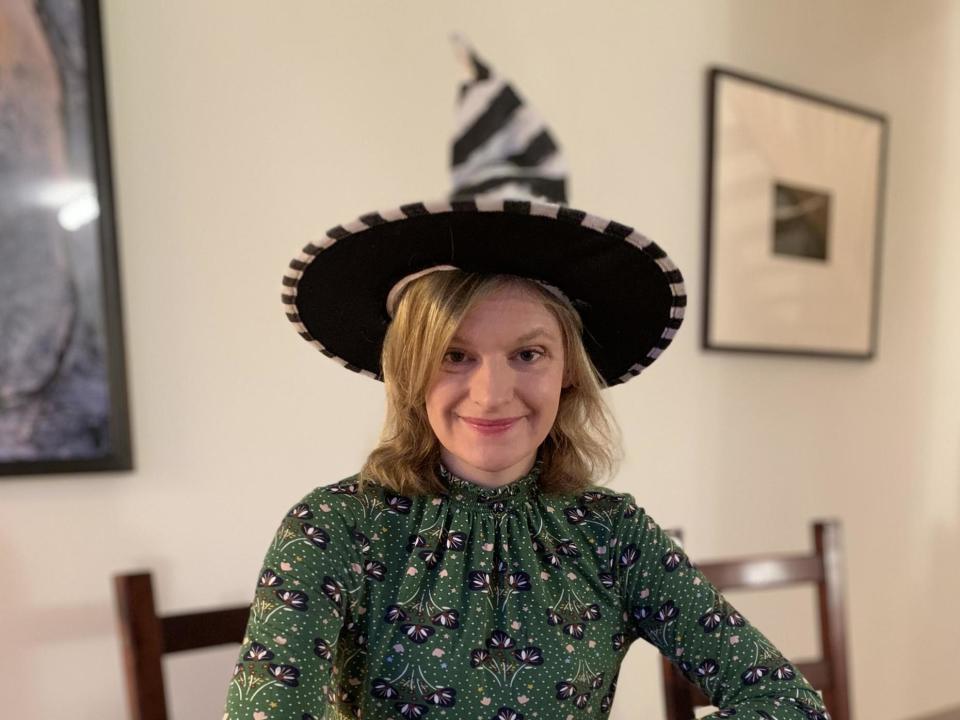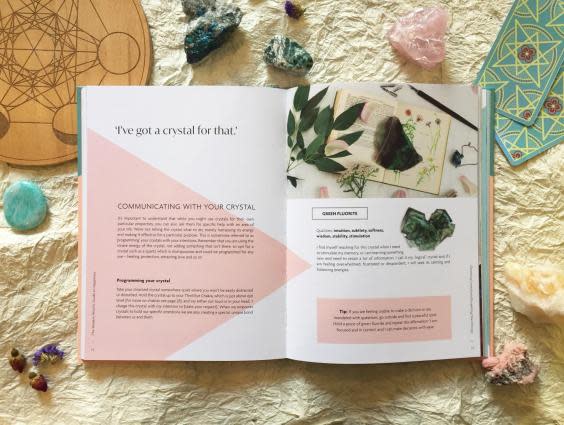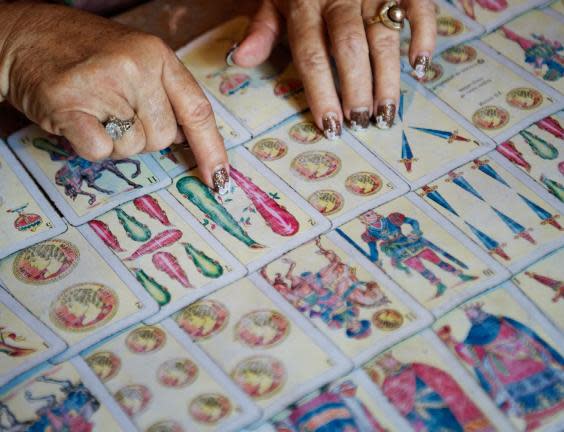I spent a week becoming a witch and the results were worrying

It’s the new year. I could have given up booze and bacon, or embarked on a punishing new fitness regime. But these seemed too harsh for the drab days of January and besides, I had more ambitious plans for personal transformation. Namely, to turn myself into a witch.
At this opening of a scary new decade, we’re in the midst of a resurgent interest in all things mystic, superstitious or more than a little bit woo. As the New Yorker magazine observed, “astrology is currently enjoying a broad cultural acceptance that hasn’t been seen since the 1970s”. And its cousin in dogged resistance to logic, specifically witchcraft, is also having something of a moment, refitted for the age of self-care as a way for women to reconnect with themselves and the natural world. Think crystals, not cauldrons. Last summer, Publishers Weekly noted that witchcraft was one of the strongest trends in the “mind-body-spirit” category, and the interest shows no sign of abating.
While never knowingly on trend – it took me five years to attempt a jumpsuit – I decided, for once, to seize the cultural zeitgeist. I picked up a copy of the newly published The Modern Witch’s Guide to Happiness by Luna Bailey and set my cynical self a New Year, New Me challenge.
Monday
Right. This witching business. One of the things I need, along with a suspension of belief in the scientific underpinnings of the universe, is an altar. Not to sacrifice a goat upon – no, this book is whiter than a student union snowflake – but to claim a space for “creativity, spiritual growth and guidance”. Recommendations include some bright cloth, salt (“protective and purifying and represents the Earth’s energy”), plus objects to suggest earth, fire, air, water and spirit. I manage a pot plant, a small bottle of Polish plum vodka (spirit and fire in one – boom) and a stripy scarf. It doesn’t look anything like the Instagrammable extravaganza in the book, but at least it made me tidy my bedside table. By the end of the day, though, it has been joined by a light smattering of cat hair and my four-year-old’s lego T rex. Is the universe trying to tell me something?

Tuesday
Crystal-shopping time: no self-respecting witch in this new age of Aquarius would be without these ubiquitous lumps of pretty rock. I take myself to a gift shop. The book informs me that I should allow myself to be drawn to the crystal that has meaning for me. I position myself in front of a stand of crystal bracelets. Will it be the pastel-pink rose quartz, with qualities of “love, peace and tenderness” apparently laced into its silicon and oxygen atoms; or the “playful” inky-black bornite? I close my eyes, then open them. I found myself uncannily drawn to something, after all. It’s the price tag. Ten quid! I am propelled out of the shop by unseen forces.
Wednesday
Finally, some advice I can wholeheartedly embrace: five tips for making simple connections with nature, from touching leaves to noticing sights and sounds. Tricky but not impossible if you’re schlepping to work on the tube; easy where I live and instantly soothing. A frail yellow autumn leaf clinging by a thread; a rubbery weed poking through a desert of gravel; you get the picture. Another edict is to appreciate the seasons, including picking up an acorn or pine cone in autumn and keeping it through winter. Turns out I was witchy all along, as some colleagues would probably attest: in my coat pocket I still have a perfect, hard conker that I found in October. I don’t believe it offered me protection through the winter months, as the book claims; I just like the feel of it. I suspect a large part of the appeal of witchcraft today is the emphasis it places on slowing down, switching off from your phone and taking notice of the natural world.

Thursday
Since I am well into my first week as a witch, I decide the time has come to attempt my first spell. None of the “magick” incantations listed involve putting a pox on my enemies, which will be a relief to the landlord who has failed to fix my broken boiler; they’re all perky personal growth exercises. After a skim, I settle on a “burning and banishing spell”. This involves writing down worries or unwanted personality traits on a piece of paper, then setting fire to it. Next to “tax return” I put “knee-jerk scoffing cynicism”. I would have set it on fire but I was too cynical to waste a match.
In fairness, there is a reasonable body of evidence to suggest that “journaling” is good for us. Taking time to think about and articulate what we want to let go of is no doubt psychologically healthy; for me, it’s the puff of smoke that’s a step too far.

Friday
The last weekday, and time to take it up a level: I open the chapter on tarot and prepare to dabble in divination. I don’t have an actual set of cards, but witchcraft has a relaxed, homespun kind of vibe so I improvise. I raid my daughter’s toy drawer, find a set of sea-creature playing cards, and get reading. I must focus on my personal objectives, then hold the cards or lay them on a surface. The book suggests I start by selecting three cards and using them to answer three questions: “What is my dream? What is stopping me? What is the reality?”

I turn three cards over: dolphin, shark, dolphin. The interpretation should apparently come from my own intuition. Dolphins are playful creatures; sharks are scary. For an actual moment, I find myself thinking: this makes sense! I want to spend more time on creative work; fear is holding me back; but the reality is I’m still a creative person underneath.
And there we have it: confirmation bias. You go looking for a pattern, and you will find it, even in a pack of deeply non-mystic marine-animal cards bought to entertain a small child on a rainy holiday in France. Our brains are built to leap to conclusions, to see what’s not really there – helpful if the twitching leaves might hold a crouching sabre-toothed tiger; misleading in modernity. It’s part of the reason we’re all such credulous suckers, still seduced by superstition at a time when we have the technology to make a space probe orbit Saturn.
Saturday and Sunday
I spend the weekend pondering all things witchy. On the one hand, it’s hard not to snort coffee through your nostrils when you read that water that has had rose quartz soaking in it can be given to soothe traumatised animals. On the other, witchcraft is no less irrational than any other religion and many of its practices are in fact a fairly reasonable response to the major challenges of our time. Rediscovering nature, reclaiming the sexist trope of the witch as a symbol of female empowerment, switching off from the constant thrum of social media and consumerism: what’s not to like?

The answer, of course, is that however benign or even beneficial the rituals, it’s all built on a wobbling base of bats***. No matter how many spells we cast to ask the universe for help, the universe isn’t listening. On a personal level, it’s probably better for us to just accept that life doesn’t always go our way and lower our expectations: Catherine Gray’s wonderful The Unexpected Joy of the Ordinary is a lovely new year read on finding the magic (no k needed) in the mundane. And on a broader level, the recent zest for the mystic is part of a worrying backlash against the enlightenment values that have driven human progress. On the one end of the political spectrum, you get the anti-vaxx movement; on the other, climate change deniers. Standing in the light of a full moon to recite our resolutions may be harmless, but as a society we shun science at our peril.

